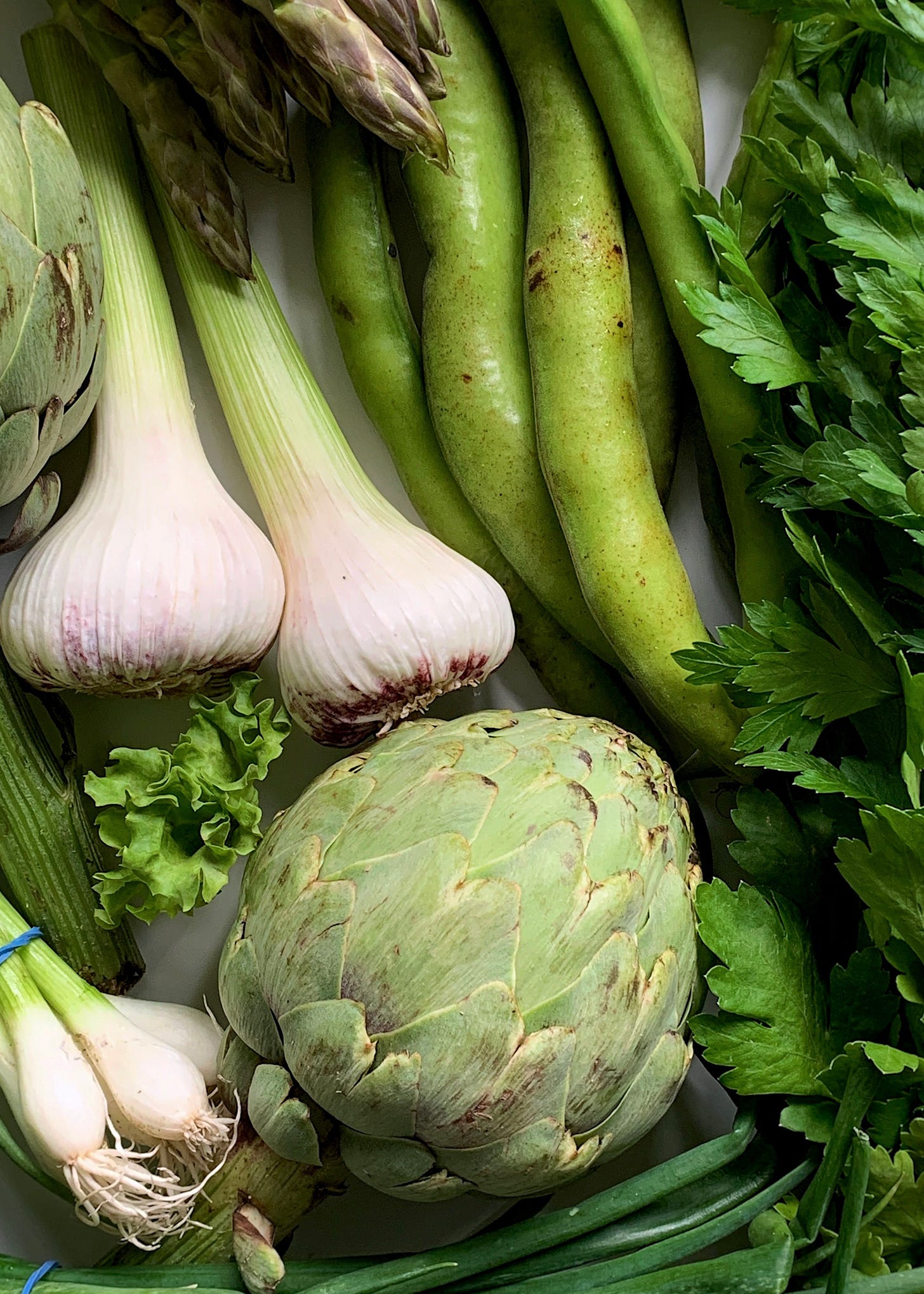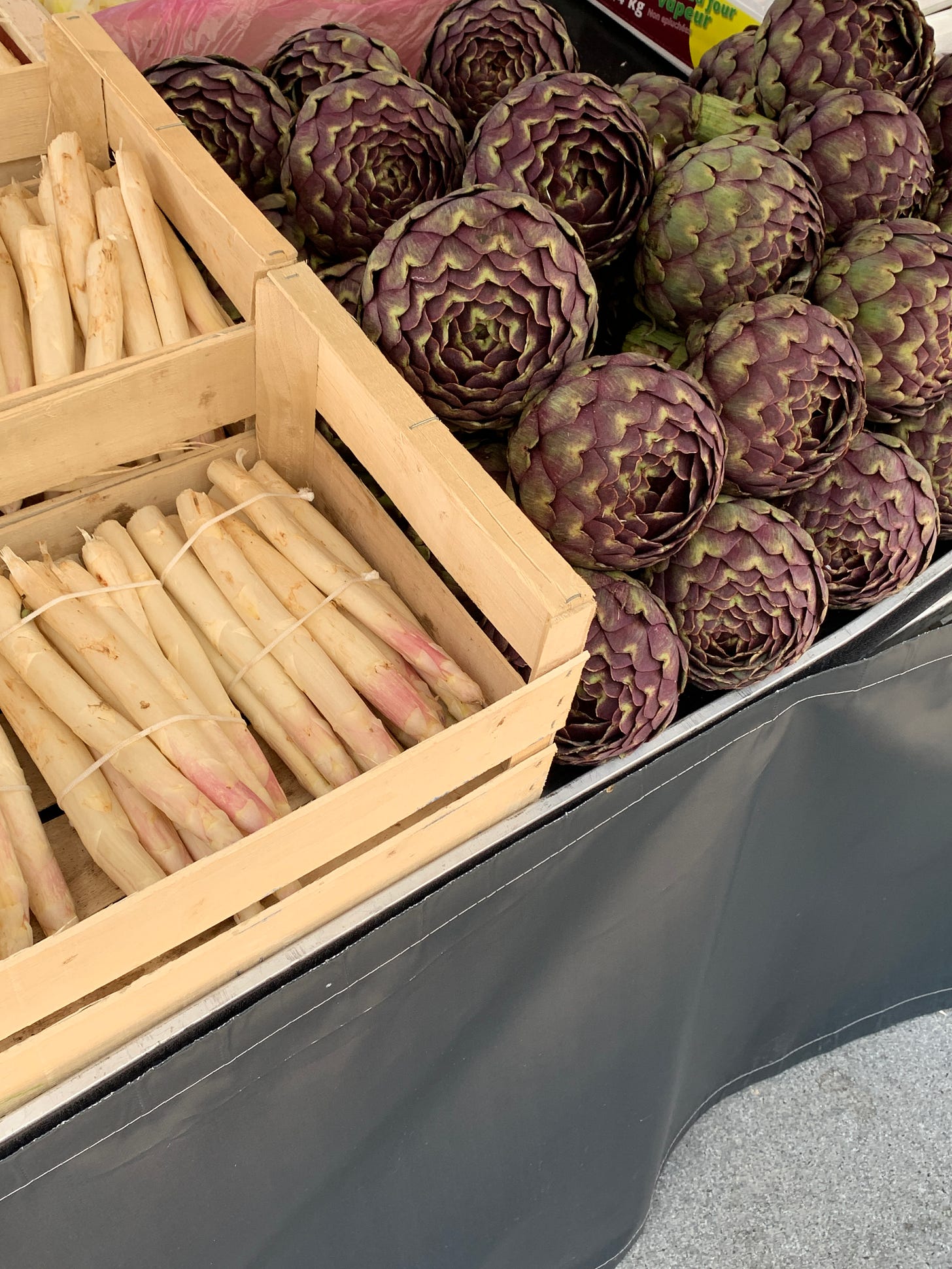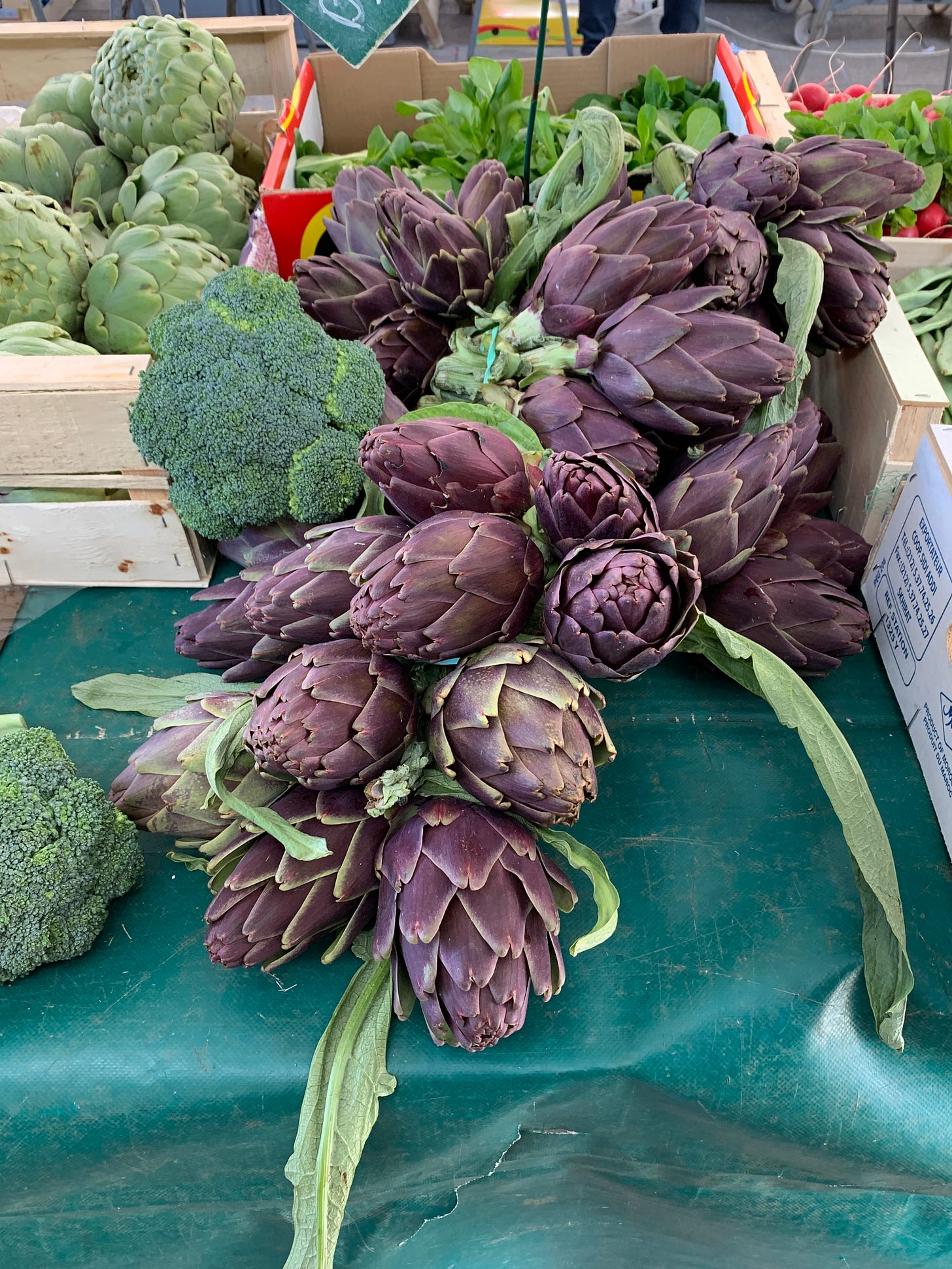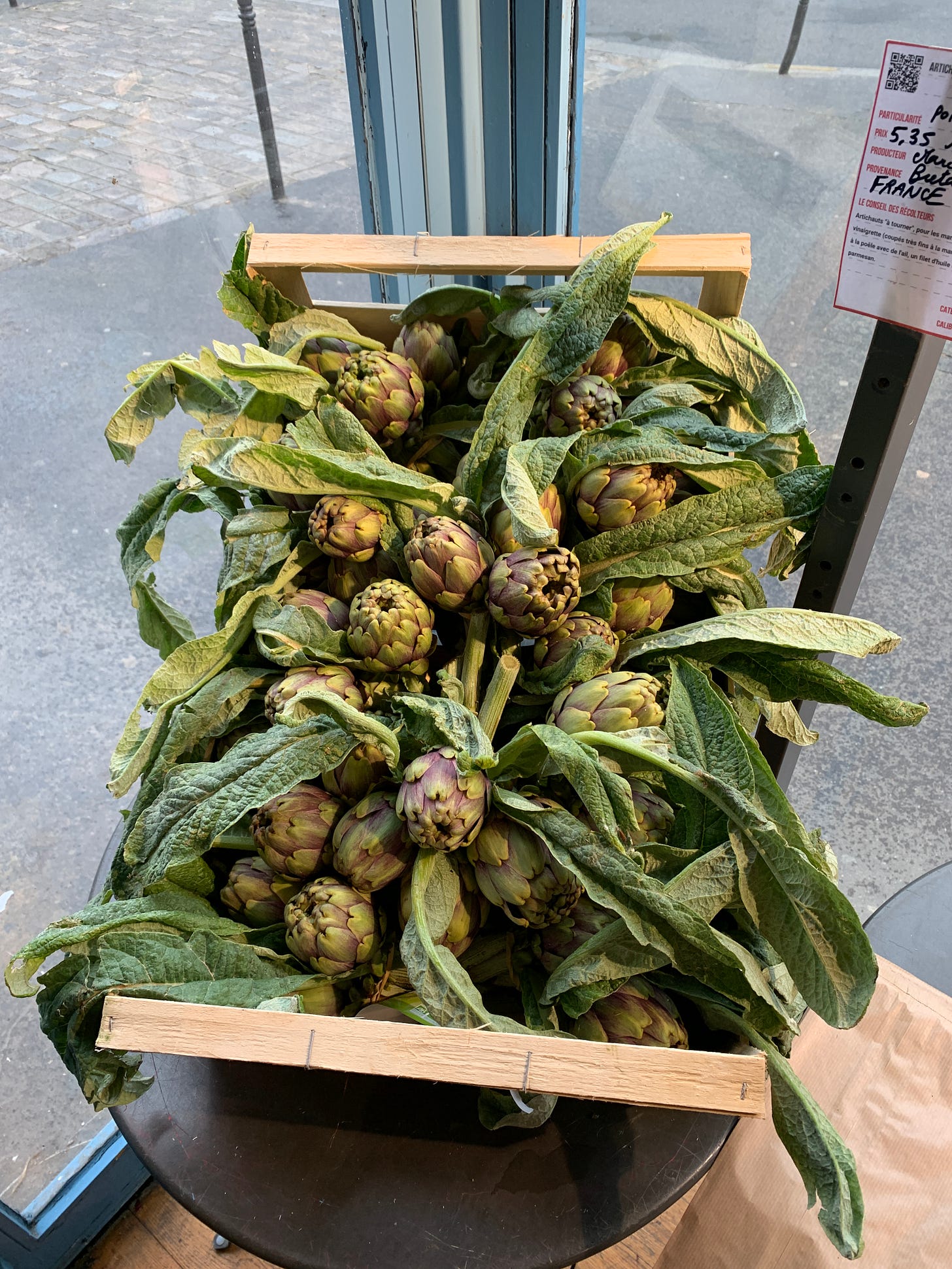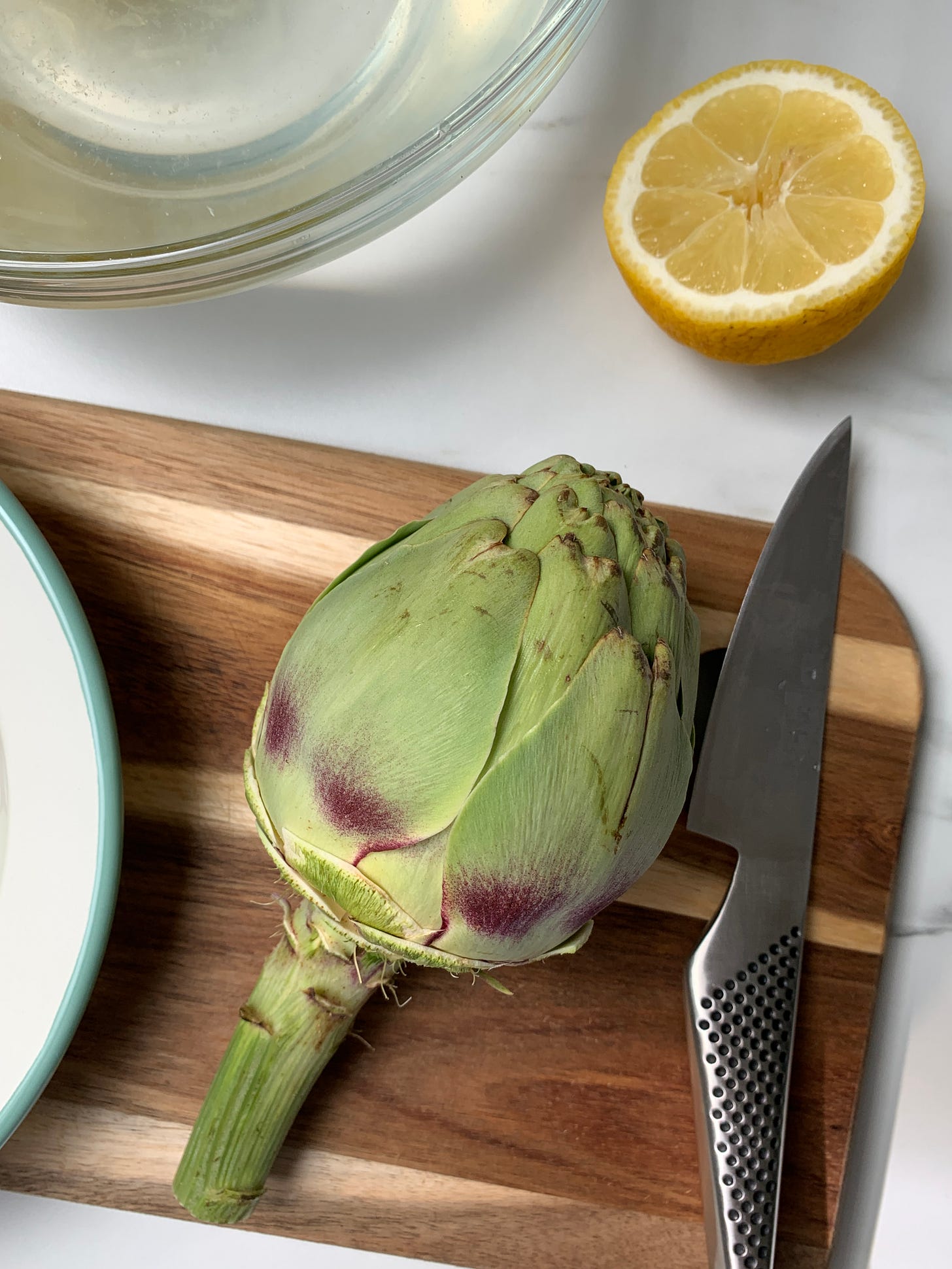👋+: One Artichoke, Three Dishes
tenderhearted thistles + mastering the art of guilt-free eating
Allô! 👋
Welcome (back) to the seasonal sundays supplement to the monthly good food at home newsletter, where every week we take a closer peek at produce at its peak — with a short introduction, at least one recipe, and a (sometimes related) cooking Q&A. Thank you for reading! If you haven’t subscribed yet, you can find all previous issues here. Annual subscriptions are currently discounted for a limited time.
Happy Sunday, and happy June! I hope you’re all doing well. Hard to believe that we’re nearly halfway through the year already. This week, we’re talking artichokes.
ARTICHOKE SEASONALITY & ORIGIN
Artichokes, the (occasionally thorny) buds of immature thistle flowers, are a perennial plant native to the Mediterranean. Much like the wild cardoons they were cultivated from (and perhaps much like you too), they aren’t all that fond of below-freezing temperatures and so tend to be grown in warmer climates (that said, we’ll soon learn that they don’t handle extreme heat all that well either).
Most commonly grown commercially in Egypt, Spain, and Southern Italy (though also abundant in Algeria, China, Peru, Morocco, the USA, and Turkey), you can usually find them in markets and grocers across the globe, which can make understanding their origin and seasonality a little bit tricky. (Speaking of which, you can also grow them as annuals in cooler climates — and a number of farmers do — which helps to extend their season, availability, and diversity around the world, as well as adding to the potential confusion surrounding their seasonality and origin.)
In Italy, artichokes are known to come to market as early as December. In France, you’ll often first see different varieties of artichokes from March and into June. In Egypt, they are most commonly harvested between November and April, while in more temperate or continental climates like those of the UK, Northern USA or Southern Canada, you’re most likely to find locally-grown varieties in mid- to late summer. Meanwhile, in California, fresh artichokes are grown and made available year-round. And, in every zone, there is usually the possibility of a second, smaller crop in the fall.
If this supposedly clarifying information leaves you further befuddled, you’re not alone.
The main thing to remember is that it depends on the varieties and where they are grown. So, while artichokes can be found year-round and across a range of climates, note that those grown in native or native-like hardiness zones are usually best between February and May, while those grown in less traditional hardiness zones are more likely to be harvested from May to August, with both having the possibility of a second, smaller crop anywhere from September through to December.
In Norway, where I live, artichokes tend to be imported year-round from France, Spain, Italy, and Egypt, however the ones that are easiest to find in my neck of the woods always seem to arrive between May and June from France's northwest.
note: if you live in California, you may want to check out the Artichoke Festival happening next weekend — it’s been going on since 1959, and every year they crown an Artichoke Queen, the first of whom was Marilyn Monroe (!)
ARTICHOKE VARIETIES, FLAVOUR NOTES & PAIRINGS
Artichokes range from small and elongated to large and round, from purple to green, and from spiky to smooth-tipped, with all sorts of combinations and permutations in between — Green Globe, Romanesco, Violetta are some of the most popular varieties. What is common to all is that they must be harvested before the heat of summer transforms their meaty flesh into a giant inedible thistle flower.
Despite being praised by many, the flavour of artichokes can be somewhat hard to put into words. Somewhere between vegetal and earthy, it can be described as creamy and even nutty, and its taste can go from mildly bitter when raw to succulently sweet when cooked. Some people say the aroma is reminiscent of fried egg whites, while others still place it somewhere between broccoli stems and asparagus, cabbage and celery. I can’t say I fully agree with any of these — I think a lot of it comes down the variety and how you prepare it — but I do recommend you try them if you haven’t yet, as one thing most of us seem to agree on is that the flavour is well worth the wait.
Common pairings include garlic, lemon, fennel, capers, spinach, and thyme, as well as white wine, butter, olive oil, Parmesan, and most things creamy and dairy.
ARTICHOKE SHOPPING TIPS
In-season artichokes are usually best when very fresh, so when shopping for buds, look for vibrant ones, heavy for their size (i.e. not dried out) that look recently plucked (the cut base of the stems should not look overly oxidised or dry). Limp leaves, dull stalks, and dry tips can all be a sign of an artichoke that may have been sitting a little too long.
As to whether or not your artichoke was plucked at the right time, you’ll want to keep in mind that if left to grow too long, the leaves will open up, the heart and stem will turn fibrous, and the choke will blossom into an inedible flower: this means you’ll want the leaves to be relatively compact. One way to test for this is to give the artichoke a little squeeze: if they feel firm but with a little bit of give, and the top leaves let out a slight squeak, you should be good to go.
Note that if the outer leaves have been exposed to a little bit of frost, they may brown or blacken a little. This discolouration is mostly cosmetic, so not always a good test of whether or not an artichoke is a good pick (in fact, some argue that the exposure to some cold gives the artichoke heart an even sweeter taste).
ARTICHOKE PREPARATION & STORAGE
The way to cook and eat an artichoke is not intuitive, so you’d be forgiven for not knowing how to approach one for the first time. The main things to keep in mind are that most varieties have a hairy choke* in the middle which must be removed as they are not pleasant to eat, and that the top halves of the leaves are usually not eaten either as they are too fibrous. (If you’re more of a visual learner, this video gives a great quick overview on which parts people usually eat.)
When cutting an artichoke, it is common to reserve the trimmed flowerheads in a bowl of water acidulated with squeezed lemon slices or parsley stalks and leaves, to stop the green flesh from oxidising and turning brown before it is cooked. (This can also help to give the spaces between the leaves a bit of a rinse.)
Artichokes can be prepared raw, thinly sliced, or trimmed, in such a way that the meaty flesh located at the base of the leaves and in the heart of the bud can more easily be enjoyed. Common preparations involve boiling, steaming, or deep-frying the artichoke whole, halving it to roast or braise, or cutting away the leaves and chokes (if any) to grill or marinate the hearts.
Plan to enjoy your artichokes ideally within four to five days of purchase (though the fresher, the better). The best way to store them is in a plastic bag, loosely wrapped in a barely moistened cloth (so as to keep them from drying out or being in direct contact with the cold), and tucked away into the crisper drawer of your refrigerator.
*if picked early and small, however, some golfball-sized varieties do not yet contain a choke and can be eaten whole
•••
one artichoke, three dishes 🍋
Artichokes aren’t all that hard to prepare, but they also aren’t all that straightforward to tame. (Do not fret, however: once you get the hang of it all, preparing and enjoying artichokes on the regular really becomes breezy.)
If you’re going to go through the trouble of preparing some, I suggest making the most of the giant thistle buds and making three dishes (plus one condiment) out of one star ingredient:
INGREDIENTS
serves as many as you like, as an appetiser — account for half to one whole artichoke per person
Keep reading with a 7-day free trial
Subscribe to good food at home to keep reading this post and get 7 days of free access to the full post archives.





